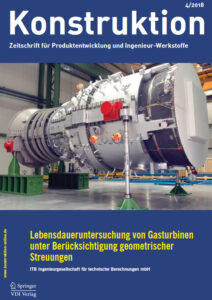Gas turbines are subjected to some of the highest loads of all machines. Massive operating pressures and in particular high temperatures, and the resulting loads, represent huge challenges for the calculation engineer. Moreover, the mechanical behaviour of gas turbines is characterised by temperature-driven long-term influences, which mean materials exhibit a high degree of non-linear behaviour, and the fact that the contact situations between components are complex.
At the same time, the development of gas turbines is characterised by the need to increase the service life while simultaneously extending maintenance intervals. SIEMENS AG therefore approached our company with a request to investigate the influence of manufacturing tolerances on the service life of a gas turbine. Specifically, the service life of a gas turbine housing was to be investigated in terms of LCF.
First, we collected data concerning the manufacturing tolerances using 3D laser surveying on gas turbine housings. Based on the measurement data, CAD models were created of the actual condition of the gas turbine housing. The challenge here was the handling of large amounts of data and the creation of parameterised CAD models, which was a prerequisite for the subsequent sensitivity analysis using the OptiSlang program system. In order to increase the number of geometry variations, additional artificial geometries were created based on the measured gas turbine housings, using what is known as synthetic random field models.
Based on the measured and virtually generated parameterised CAD data, a large number of transient thermomechanical calculations were carried out as part of the sensitivity analysis. The results of all calculations were then evaluated using the LCF software “Siemens GT” in terms of service life.
As a result, it was possible to identify which tolerances and geometry parameters had a significant or no significant influence on the service life of the gas turbine. Based on these findings, it becomes possible to redefine the tolerance fields of the gas turbine housings in order to extend maintenance intervals and thus the service life of the gas turbine and to reduce manufacturing costs.
You might also be interested in the following pages:
Sensitivity analysis to determine the influence of individual parameters
Use of FEM calculations for gas turbine housings

